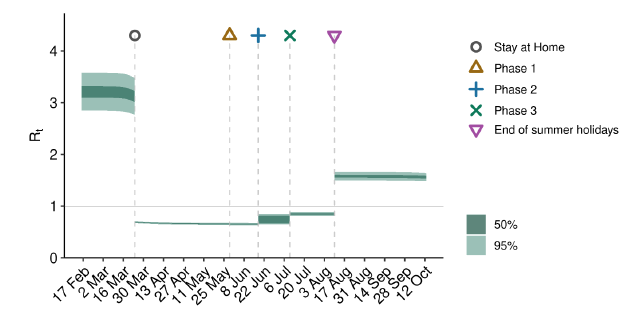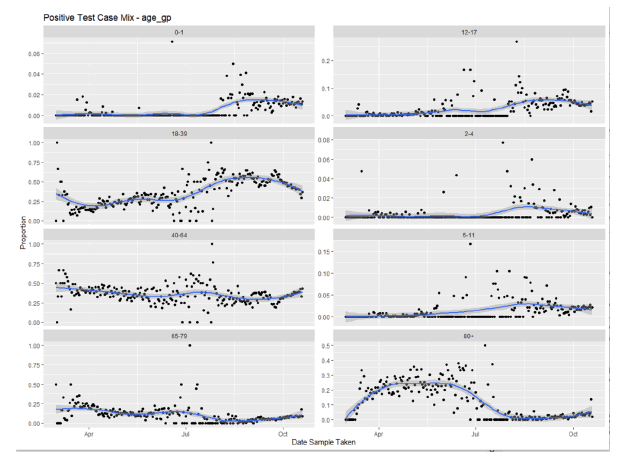Coronavirus (COVID-19): modelling the epidemic (issue no. 23)
Latest findings in modelling the COVID-19 epidemic in Scotland, both in terms of the spread of the disease through the population (epidemiological modelling) and of the demands it will place on the system, for example in terms of health care requirement.
Coronavirus (COVID-19): modelling the epidemic in Scotland (Issue No. 23)
Background
This is a report on the Scottish Government modelling of the spread and level of Covid-19. This updates the previous publication on modelling of Covid-19 in Scotland published on 15 October 2020. The estimates in this document help the Scottish Government, the health service and the wider public sector plan and put in place what is needed to keep us safe and treat people who have the virus.
This edition of the research findings focuses on the epidemic as a whole, looking at estimates of R, growth rate and incidence as well as local measures of change in the epidemic.
Key Points
- The reproduction rate R in Scotland is currently estimated as being between 1.2 and 1.5.
- The number of new daily infections for Scotland is estimated as being between 154 and 330, per 100,000 people.
- The growth rate for Scotland is estimated as being between +4% and +7%.
- The estimated doubling time for Scotland was between 10 and 15 days.
- Forecasts indicate that hospital admissions will continue to rise over the next two weeks.
Overview of Scottish Government Modelling
Epidemiology is the study of how diseases spread within populations. One way we do this is using our best understanding of the way the infection is passed on and how it affects people who catch it to create mathematical simulations. Because people who catch Covid-19 have a relatively long period in which they can pass it on to others before they begin to have symptoms, and the majority of people infected with the virus will experience mild symptoms, this "epidemiological modelling" provides insights into the epidemic that cannot easily be measured through testing e.g. of those with symptoms, as it estimates the total number of new daily infections and infectious people, including those who are asymptomatic or have mild symptoms.
Modelling also allows us to make short-term forecasts of what may happen with a degree of uncertainty. These can be used in health care and other planning. The modelling in this research findings is undertaken using different types of data which going forward aims to both model the progress of the epidemic in Scotland and provide early indications of where any changes are taking place.
Modelling outputs are provided here on the current epidemic in Scotland as a whole, based on a range of methods. Because it takes a little over three weeks on average for a person who catches Covid-19 to show symptoms, become sick, and either die or recover, there is a time lag in what our model can tell us about any re-emergence of the epidemic and where in Scotland this might occur. However modelling of Covid deaths is an important measure of where Scotland lies in its epidemic as a whole. In addition the modelling groups which feed into the SAGE consensus use a range of other data along with deaths in their estimates of R and growth rate. These outputs are provided in the first part of this research findings. The type of data used in each model to estimate R is highlighted in Figure 2.
A short term forecast of the number of cases and hospitalisations in the next two weeks is also provided, as the focus at this stage of the epidemic is the re-emergence of the virus in Scotland.
What the modelling tells us about the epidemic as a whole
Figure 1 shows how Rt has changed since February. Before the "stay at home" restrictions were put in place Rt was above 1, and most likely to have been between 3 and 4 before any interventions were put in place.

Source: Scottish Government modelled estimates using Imperial College model code; actual data from https://www.nrscotland.gov.uk/statistics-and-data/statistics/statistics-by-theme/vital-events/general-publications/weekly-and-monthly-data-on-births-and-deaths/deaths-involving-coronavirus-covid-19-in-scotland
The various groups which report to the Scientific Pandemic Influenza Group on Modelling (SPI-M) use different sources of data in their models (i.e. deaths, hospital admissions, cases) so their estimates of R are also based on these different methods. SAGE's consensus view across these methods, as of 21 October, was that the value of Rt in Scotland was above 1, between 1.2 and 1.5, meaning that the epidemic is growing exponentially. The R value estimated by the Scottish Government falls within this range, and is similar to the estimates of other modelling groups (Figure 2).

Source: Scientific Advisory Group for Emergencies (SAGE).
On 20 October, Public Health Scotland recorded 1,456[1] positive new cases, with 8,759 positive new cases over the week of 14 – 20 October.
The various groups which report to the Scientific Pandemic Influenza Group on Modelling (SPI-M) use different sources of data in their models to produce estimates of incidence. SPI-M's consensus view across these methods, as of 21 October, was that the incidence of new daily infections in Scotland was between 154 and 330 new infections per 100,000. This equates to between 8,400 and 18,000 people becoming infected each day in Scotland.

Source: Scientific Pandemic Influenza Group on Modelling (SPI-M).
The consensus from SAGE for this week is that the growth rate in Scotland is between +4% and +7% per day. Last week the growth rate was in the range +6% to +9%.
The spread of the epidemic can be expressed in terms of the length of time it takes for numbers of new daily cases to double. Doubling times were provided by SPI-M on 21 October. The consensus estimated doubling time for Scotland was between 10 and 15 days.
Figure 4 shows the epidemiological model forecasts of daily deaths produced by the Scottish Government, given the present set of interventions. This measure of the epidemic is forecast to increase in the weeks ahead.
Figure 4. Scottish Government short-term forecast of the number of deaths from Covid-19 in Scotland, based on actual data (13 October).

Source: Scottish Government modelled estimates using Imperial College model code; actual data from https://www.nrscotland.gov.uk/statistics-and-data/statistics/statistics-by-theme/vital-events/general-publications/weekly-and-monthly-data-on-births-and-deaths/deaths-involving-coronavirus-covid-19-in-scotland
The logistical model developed by Scottish Government analysts to assess implications for health care demand (see previous Research Findings) has been adapted to produce a short-term forecast of cases.
The following two week ahead predictions use this model to extend the estimated number of infections from the Imperial College model, in a manner that fits with the estimated number of actual cases, adjusting positive tests to account for asymptomatic and undetected infections. The extension begins in mid-July, and assumes an Rt value rising to 1.6. Future Rt values are based on agreed assumptions.
Figure 5 shows two predictions from this model - a "better scenario", which assumes the current Rt value was reduced significantly as a result of measures announced on 7 October, and a "worse scenario", which assumes that transmission decreased only by a small amount. In comparison to this chart in previous versions of this paper, the estimate of actual new infections has been shifted 5 days earlier than the positive tests timeline it is based on, to account for the delay between people being infected and developing symptoms.

What we know about who is testing positive with Covid
The Early Pandemic Evaluation and Enhanced Surveillance of COVID-19 (EAVE) 2 Study Group[2] have looked at the pattern of demographics and clinical risk groups over time for those who tested positive. This permits a forecast of the expected number of positive test cases within the population, including older people and those with co-morbidities. The forecasts use data available up to 12 October. This second wave of the epidemic has been characterised by younger people testing positive. However, the number of people who are testing positive who are older or have a number of co-morbidity conditions has increased and, based on data to 12 October, 13% of people now testing positive are 65 or over (Figure 6).

At the end of August, about 70% of those testing positive were categorised as not being in a clinical risk group, decreasing in September to about 60% and now in mid-October to about 50%.
Since August there have been increases in the proportions testing positive with three or more risk groups, this has now reached about 20%.
As the number of people who are older and within at-risk groups grows more people are forecast to require hospitalisation. Using the infection forecast in Figure 5 and the information from EAVE 2 gives a two week forecast of hospitalisations (Figure 7). This forecasts a continued rise in hospital cases of up to about 120 (Better) and about 180 (Worse).

The Scottish Contact Survey
A new tranche of results are available from both panels of the Scottish Contact Survey (SCS). These are currently being processed, and the results will be presented in future weeks.
What next?
The Scottish Government continues to work with a number of academic modelling groups to develop other estimates of the epidemic in Scotland.
The modelled estimates of the numbers of new cases and infectious people will continue to be provided as measures of the epidemic as a whole, along with measures of the current point in the epidemic such as exceedance. Rt and growth rate will also be provided. Further information can be found at https://www.gov.scot/coronavirus-covid-19.
Technical Annex – EAVE 2
The EAVE 2 Study[3] Group have derived a statistical prediction model for Covid death, and hospitalisation with Covid, using demographic information (age, sex, deprivation) together with up to 26 risk groups derived for General Practitioner data such as Asthma, Diabetes, Chronic Obstructive Pulmonary Disease (COPD) etc.
Data from the Public Health Scotland Electronic Communication of Surveillance in Scotland (ECOSS) system has been linked to the EAVE General Practitioner data to give a short term forecast of anticipated hospitalisations and deaths associated with increased numbers testing positive. ECOSS is a database that holds surveillance data on various microorganisms (eg. influenza virus and coronavirus) and infections reported from diagnostics and reference laboratories. Data on laboratory results for all reverse transcriptase PCR (RT-PCR) tests carried out in Scotland are being collated by ECOSS. The ECOSS test positive data base is then linked to the EAVE cohort of virtually all patients registered with a GP in Scotland. Those who tested positive have been selected out to look at the pattern of demographics and risk groups over time.
Clinical at-risk groups refer to individuals with certain underlying medical conditions who are at-risk of Covid-19 related complications and for whom seasonal influenza vaccination is recommended. The following clinical at-risk conditions are considered: (A) chronic respiratory disease (with chronic obstructive pulmonary disease and asthma as subsets); (B) chronic heart disease; (C) chronic liver disease; (D) chronic kidney disease; (E) chronic liver disease; (F) chronic neurological disease; (G) diabetes types 1 and 2; (H) conditions or medications causing impaired immune function; (I) pregnancy; (J) asplenia or dysfunction of spleen; (K) obesity (body mass index (BMI) <20, 20–25, 25–30, 30–39 and ≥40 kg/m2); (L) hypertension (subsets controlled/uncontrolled hypertension); (M) tuberculosis and (N) multimorbidity[4].
This work has received full Public Benefit and Privacy Panel (PBPP), Ethics and NHS Research approval. The GP Data was extracted by Albasoft.
A statistical prediction model is used to give forecasts of deaths and hospitalisations in Scotland from clinical characteristics. We will continue to report findings from this model which indicates changes in the rate of positive tests and hospital admissions for different groups.
Contact
There is a problem
Thanks for your feedback